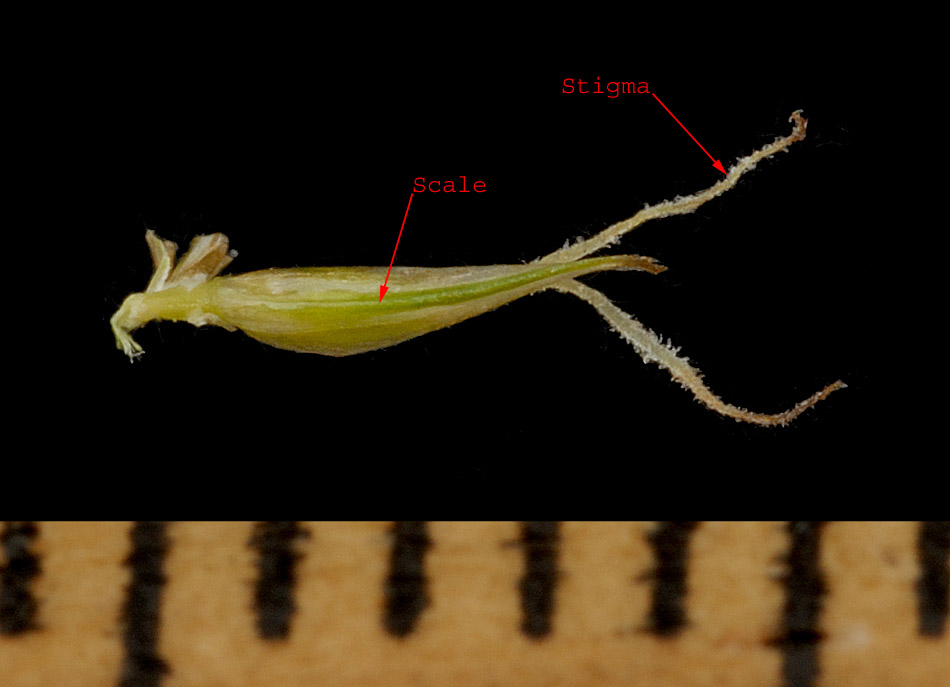 | Douglasii:
Answers to key questions in Sedges (Carex) of Saskatchewan, Fascicle 3,
Flora of Saskatchewan by Anna Leighton leading to this species. The
answers are in the order you would normally work through the key.
 |
Stigmas 2;
achenes lenticular; NOT [Stigmas 3; achenes three-sided, occasionally
terete, though their shape may be concealed by flattened perigynia.] |
 |
Spikes 2
or more per culm, terminal and lateral; spike bracts present on lateral
spikes; lowest spike bracts usually evident, often conspicuous, even in
compact heads composed of densely bunched and indistinguishable spikes
(except in C. maritima, C. chordorrhiza and C. microptera); NOT [Spikes
1 per culm, terminal; spike bracts absent] |
 |
Individual
spikes distinguishable in an open inflorescence, or indistinguishable in
a compact head; spikes in any one inflorescence alike in appearance due
to their similar composition (i.e. all are gynecandrous, androgynous,
pistillate or staminate), sessile. NOT [Individual spikes
distinguishable in an open inflorescence (densely bunched in C.
bicolor); spikes in any one inflorescence either markedly different in
appearance (with terminal spike staminate and lateral spikes
pistillate), or subtly different in appearance (with terminal spike
gynecandrous and lateral spikes pistillate), sessile or stalked.] |
 |
Culms
single, or a few together, well-spaced along conspicuous rhizomes or
stolons. NOT [Culms loosely to densely cespitose (occasionally
mat-forming rather than in discrete clumps); rhizomes, if present,
usually short with culms arising close together along them.] |
 |
Culms
growing directly from 1-3 mm wide, horizontal rhizomes; NOT [Culms
growing singly from stolons formed by reclining vegetative shoots that
elongate horizontally and become overgrown by moss; rhizomes short and
rarely collected; perigynia 2.5-3.5 (4.5) mm long, red-brown to dark
brown, shiny, faintly to prominently red-brown nerved; plants of
sphagnum bogs] |
 |
Some
spikes may be indistinguishable at tip of inflorescence, but usually at
least lower spike is visually distinct (except in oft-collected immature
heads of C. duriuscula); perigynia not two-toned as in C. maritima;
plants not restricted to far north. NOT [All spikes
indistinguishable in an ovoid to +/- round head; perigynia irregularly
two-toned (pale on lower half, darker on upper half and beak); plants of
gravel substrates in far north.] |
 |
Perigynia
usually less than 4 mm long, or if longer, then pistillate scales
completely covering perigynia; all spikes in inflorescence alike in sex:
androgynous in monoecious plants, unisexual in dioecious plants.
NOT [Perigynia (3.5) 4-6.5 mm long; pistillate scales usually shorter
and narrower than perigynia; spikes in inflorescence similar in
appearance but unlike in sex: terminal androgynous, gynecandrous or
pistillate; middle +/- staminate; lower +/- pistillate.] |
 |
Ventral
strip translucent and nerveless (though underlying nerves on the culms
may be visible through strip); no special warts at junction of blade and
leaf-sheath; spike density variable with spikes at various angles and
less visibly ranked; plants monoecious with androgynous spikes or
dioecious with unisexual spikes. NOT [Ventral strip opaque and
green-nerved to hyaline summit; two small warts often present at
junction of blade and leaf-sheath; spikes closely packed but
distinguishable, regularly arranged, uniformly ascending at an angle of
about 45 degrees and arrayed in definite ranks; plants monoecious with
androgynous spikes] |
 |
Plants
short, culms seldom over 3 dm high, growing singly or a few together
from slender rhizomes; plants monoecious or dioecious. NOT [Plants
taller, culms seldom under 3 dm high; growing singly at regularly
intervals in a line from coarse rhizomes; plants usually dioecious.] |
 |
Inflorescence
larger, usually 1.5-4 cm long, width more than one-half the length; beak
1-2 mm long, pistillate scales 4.7-7.5 mm long, as long as, and
completely covering, mature perigynia; plants dioecious; spikes
unisexual. NOT [Inflorescence small, 0.7-1.5 (2) cm long, width
about one-third to one-half the length; beak less than 1 mm long;
pistillate scales less than 4 mm long, usually shorter than mature
perigynia; plants monoecious; spikes androgynous.] |
|

